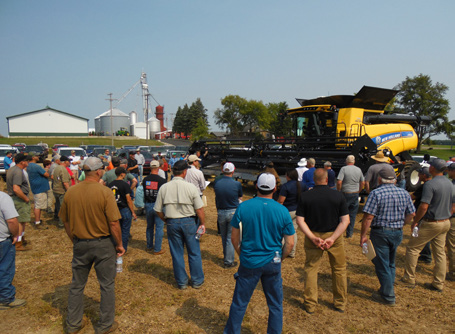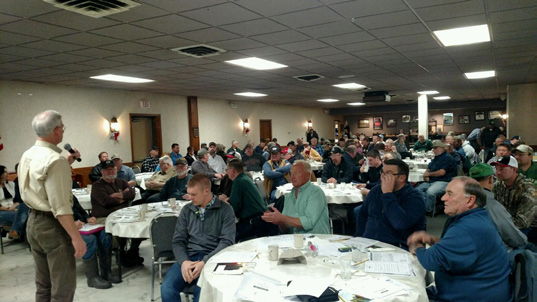
2022 Soybean Educational Programs & On-Farm Research Projects
DOWNLOADMay 1, 2023 - Michigan State University
Impacts
Soybeans are the dominant source of plant-based protein in the world. (Qin et al., 2022). They are a major feed component in global pork, poultry and aquaculture production and an important ingredient in common foods consumed in the U.S. (Krull, 2018). Seven educational programs focused on soybean production were planned, promoted, conducted and evaluated in 2022. Follow-up evaluations were mailed out to program participants at the end of the 2022 harvest season to measure and document the actual educational and financial impacts of the programs. Survey results showed:
- 71 producers earned additional income by implementing the new information they learned in 2022.
- $15.63 per acre in additional earnings was generated on 26,700 acres.
- $417,297 is the reported actual total financial impact of the programs in 2022 alone.
- 59 on-farm trials evaluated new products and management practices.
- 7 educational programs focusing on soybean production were conducted in 2022.
- 313 producers and agronomists participated in soybean-specific educational programs.
Priority Areas
Global supply chain disruptions limited availability of, and increased prices for, fertilizer and pest management products (Schnitkey et al., 2022). Soybean producers and agronomists rely on on-farm and small plot research trials as sources of information on which to base their crop input and management decisions. To provide this important research and the educational programs for disseminating the results, Michigan State University Extension and the Michigan Soybean Committee have formed a strong and productive partnership.
"You have a very good program. I especially like the testing protocols used and how they are replicated many times across the state, often for numerous years." -On-farm trial cooperator and educational program participant
For additional information regarding soybean educational programs and materials or on-farm research projects, please contact Mike Staton, MSU Extension soybean educator, by phone at 269-673-0370, ext. 2562, or by email at staton@msu.edu.

Reducing Soybean Harvest Losses
Situation:
Under ideal conditions, soybean producers lose 1 to 2 bushels on average. This translates to $14 to $28 per acre of lost income given 2022-23 soybean prices. Under more challenging conditions, the losses can increase significantly. Two such conditions confronted producers in 2022 – lodging and overly dry soybeans.
Educational methods:
A soybean harvest equipment field day was planned, promoted, conducted and evaluated in 2022. The program was co-sponsored by MSU Extension, four equipment companies, a local seed dealer and the Michigan Soybean Committee. The purpose of the field day was to demonstrate where and why soybean harvest losses occur as well as to teach participants how to measure and reduce them. To accomplish these goals, each combine operator was asked to make a common error such as driving too fast for conditions or using the wrong reel speed or reel position. Participants measured the losses after each pass and the MSU Extension soybean educator, combine operators, and equipment company representatives led discussions about reducing them.
Impacts:
More than 70 producers participated in the field day and learned new information. MSU Extension conducted a follow-up evaluation in December 2022 to measure and document the actual educational and financial impacts of this program. Thirteen of the respondents earned additional money by implementing the new information. The average amount of additional income was $11.35 per acre applied to 7,142 acres, producing an actual financial impact of $81,082 in 2022 alone.
MSU Extension is recognized as a leader in helping producers reduce soybean harvest losses as evidenced by the fact that the MSU Extension soybean educator was invited to contribute an entry on the subject to a new online Encyclopedia of Smart Agriculture Technologies.
2022 Soybean On-Farm Research & Education Program
Situation:
Soybean yield increases have not kept pace with those of corn, wheat and sugarbeets. Producers need to have access to results from replicated on-farm research trials evaluating products, practices and equipment having the potential to increase soybean yields and profitability. Also, supply chain disruptions created fertilizer shortages and high fertilizer prices for the 2022 growing season. Fertilizer is the second highest variable cost associated with raising soybeans.
Educational methods:
Fifty-nine on-farm research trials were conducted across Michigan in 2022. MSU Extension cooperated with the Michigan Soybean Committee to plan, promote, conduct, and evaluate six regional meetings in January 2022. The goals of the meetings were a) to share the 2021 on-farm research results with producers and agronomists, b) to gather input from participants regarding topics for the 2022 research projects, c) to recruit new cooperators and d) to have Kurt Steinke, MSU associate professor and MSU Extension specialist, present his latest research and recommendations for fertilizing soybeans.

Impacts:
More than 240 producers and agronomists participated in the programs. MSU Extension developed a follow-up evaluation to measure and document the actual educational and financial impacts of the program and mailed it to 243 meeting participants. Fifty-six producers said they earned additional money in 2022 by implementing the new information they learned at the program. The average amount of additional income was $16.95 per acre applied to 19,558 acres, producing an actual financial impact of $336,215 in 2022 alone.
The participants also provided specific changes they made and listed soybean topics they wanted to learn more about. This was shared with MSU Extension specialists and educators for use in developing future education and research projects.

update conducted in Caro, Michigan.
References
Krull, C. (2018, May 11). Uses for soybeans. U.S. Soy. United Soybean Board. https://ussoy.org/uses-for-soybeans/ Qin, P., Wang, T., & Luo, Y. (2022, March). A review of plant-based proteins from soybean: Health benefits and soy product development. Journal of Agriculture and Food Research, 7. https://doi.org/10.1016/j.jafr.2021.100265
Schnitkey, G, Swanson, K., Zulauf, C., Paulson, N., & Baltz, J. (2022, April 12). April update to 2022 crop budgets: Projected profits even with record costs. Farmdoc daily, 12(49). University of Illinois. https://farmdocdaily.illinois.edu/2022/04/april-update-to-2022-crop-budgets-projected-profits-even-with-record-costs.html



 Print
Print Email
Email




